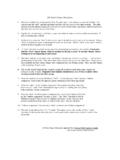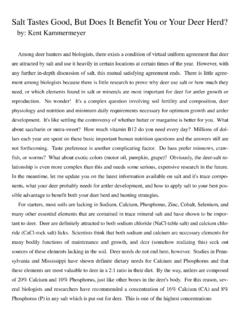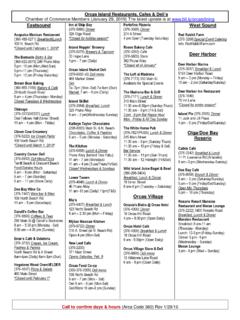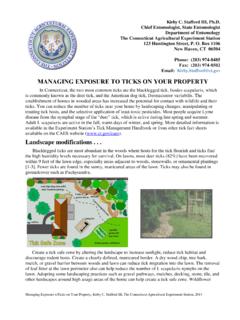Transcription of Introduction - Deer Aware
1 Larder Design 5. The deer Initiative 2008 responsibility for loss occasioned to any person acting or refraining from action in reliance on or as a result of the material included in or omitted from this publication can be or is accepted by the author(s)IntroductionThe majority of deer carcasses are destined to become food. Some carcasses will be delivered direct, but if a carcass is to be stored for even short periods it should be in kept in a larder designed to meet some minimum requirements. The aim of this guide is to highlight the design requirements for a larder which is safe, efficient, hygienic and complies with current guide links to others in the Carcass Preparation series of guides.
2 Definition of terms:Primary product:A deer carcass which may have had the head, feet and internal organs removed but which is still in the skinLarder:A storage facility where deer primary products are prepared, stored and possibly processed into venisonVenisonMeat from a deer carcass after the skin has been removedGame dealer:An Approved Game Handling Establishment (AGHE)LegislationThe EU Food Hygiene Regulations 2006 defines legal responsibilities for handling deer carcasses for sale. These regulations are interpreted for wild game in the UK by guidance issued by the Food Standards Agency (FSA)1 The legal requirements which need to be addressed at the design stage of a deer larder are.
3 Protection of primary products and venison against contamination by keeping facilities clean by using potable( drinking quality) water and, where necessary, disinfecting them (including equipment, crates and vehicles)preventing carcass handlers, pests, animals, waste and hazardous substances causing contaminationcontrolling temperature Registration of larders with the Local Authority is required for any storage facility from where deer primary products or venison are sold on to others, this includes selling to game dealers. Culling deer and using the venison for private domestic consumption only, is not affected by the EU food hygiene legislation nor does any larder have to be registered, however it is strongly recommended that these larder design criteria are applied.
4 2 Larder Design 5. The deer Initiative 2008 responsibility for loss occasioned to any person acting or refraining from action in reliance on or as a result of the material included in or omitted from this publication can be or is accepted by the author(s)LocationThe larder could be a stand alone structure or utilise an existing building. The site should:have access to a source of electricity and potable water at good pressure. permit waste water drainage by an approved meanshave good vehicular access and room to work safelybe reasonably secure, possibly screened from sightif possible, be in the shade to avoid large temperature fluctuationsallow for future expansion if requiredSizeThe size and design of the larder should take into account the number of carcasses it will be required to hold and the number of people expected to be working at any one time.
5 Ideally a space of at least 1 metre should be allowed around a carcass for working on it. In the storage area a gap of least 20cm should be allowed from wall to carcass and at least 15cm between carcasses. Outside areaA hard standing which drains well and can be easily washed. This is particularly important immediately outside the larder entrance/exit. Outside lighting is strongly recommended. PowerA single phase supply is adequate but if an industrial three phase supply could be used if available. All fittings must be suitably insulated and ( drinkable) mains water should be used where it is available. If an alternative supply is to be utilised it will need to be routinely tested for quality and water pressure and must be available all year round.
6 Floors and drainageThe cheapest acceptable flooring is concrete however other materials are available, such as polymer coating or tiles. Paint is not recommended unless specifically designed for the purpose. The floor must be non-slip, anti-corrosive and all joints and junctions with walls etc should be sealed. Floor surfaces should be in sound condition and be easy to clean and disinfect. To enable drainage, floors should have a fall of around 1 in 60 to suitably located drains with such falls constructed to ensure that water does not flow into other work areas. Drain gullies running the length of the floor are more efficient than single drain inlets. Drain inlets should incorporate debris traps with not bigger than 6mm mesh, that are easy to drains should link to external drainage to permit waste water drainage by an approved means (see By-product Disposal guide)WallsWall surfaces should be in a sound condition and be easy to clean and disinfect.
7 Walls should use impervious, non- absorbent, washable and non-toxic materials and require a smooth surface up to a height appropriate for the operations unless larder operators can satisfy their Local Authority that other materials used are appropriate. It is recommended that angles and corners should be covered to prevent accumulation of contaminants, joints and edges are sealed and non-corrodible metal or plastic sheeting is used on walls at points subject to impact roof must allow sufficient height to suspend carcasses and to allow for adequate ventilation. Ceilings are recommended. Overhead fixtures should be constructed and finished so as to prevent the accumulation of dirt, reduce condensation, and prevent the growth of undesirable mould and the shedding of particles.
8 Larder Design 5. The deer Initiative 2008 responsibility for loss occasioned to any person acting or refraining from action in reliance on or as a result of the material included in or omitted from this publication can be or is accepted by the author(s)Equipment and sinksAdequate and separate facilities should be provided for hand washing and the cleaning, disinfecting and storage of equipment. These facilities should be constructed of corrosion-resistant materials, be easy to clean and have an adequate supply of hot and cold water. Sinks should be ducted to a closed, trapped drain. Essential equipment:hot and cold water with non-hand operated taps.
9 A stainless steel sink for cleaning equipment. a stainless steel wash hand basin with liquid soap and disposable paper towels hose for floor washing, preferably with variable jet nozzleknives. Minimum 5inches long, plastic handle with scabbard and means of sharpeningbutchering saw (and scabbard) or equivalentplastic buckets and offal bins with lids marked unfit for human consumption stainless steel hooks and gambrels, chest spreaders if requiredbroom and brushes for cleaningfood safe detergent and hard surface cleanerweighing scalesmeans of recording carcass data, tags as appropriatewinch/hoist for larger deer (these should be easily cleaned and constructed to prevent contaminants such as grease from coming into contact with carcasses)suitable clothing waterproof boots, aprons/gowns, chain mail glove, hatfirst aid kitOther equipment.
10 UV fly trap (essential unless flies can be prevented by other means)variable outlet hose gunstainless steel rack for pluck/head inspection (or use hook)stainless steel work surface (if room available)stainless steel cradle or bench Rails, hoists, winchesOverhead rails maximise hanging space and ease carcass handling. Rails should be easily and safely accessible, using a hoist for larger deer . The height of rails should allow carcasses to hang with adequate floor clearance. Ideally a rail will extend out of the larder to the pick up/drop off point. Hoists and winches must be easily cleaned and constructed so that contaminants such as grease will not come into contact with are not essential but where fitted should be constructed to prevent the accumulation of dirt.









